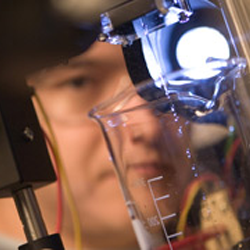
An academic industrial consortium is developing the scientific know-how to underpin a printing revolution.
An academic industrial consortium is developing the scientific know-how to underpin a printing revolution.
To help realise the full potential of inkjet printing as a robust, fast, flexible and efficient technology, we need to enhance understanding in fundamental areas.
Professor Ian Hutchings
Inkjet printing is fast becoming a major cross-sector enabling technology. Familiar to many as the process we rely on whenever we press ‘print’, the technology is now demonstrating an increasing capacity to influence a host of other industries.
Indeed, the power of inkjet printing is such that this high-precision, IT-driven technology is not only complementing conventional printing and manufacturing processes but is also becoming relevant to completely unexpected areas, as diverse as drug manufacturing, crop spraying and electronic circuitry.
But with this comes a need for improving knowledge of the science underlying the technology. ‘In many ways the development of inkjet technologies for industrial applications has moved ahead of our understanding of the basic science,’ explains Professor Ian Hutchings from the Inkjet Research Centre (IRC) in Cambridge’s Institute for Manufacturing (IfM), part of the Department of Engineering. ‘To help realise the full potential of inkjet printing as a robust, fast, flexible and efficient technology, we need to enhance understanding in fundamental areas.’
To this end, a consortium of academics and industrial collaborators led by Professor Hutchings has begun a five-year programme of research. The project has been funded with £5 million from the Engineering and Physical Sciences Research Council (EPSRC), with additional substantial support from industry.
Niche to mainstream
What makes inkjet technology so versatile is the ability to control digitally, at the level of individual droplets, precisely where the fluid appears on a surface and to change this dynamically, ‘on the fly’.
The technology dominates the desktop home and office printing market and is now edging into the commercial print market. ‘The flexibility is staggering,’ says Professor Hutchings, ‘instead of printing the pages of a single newspaper over and over again to produce many thousands of copies, an inkjet press can print all of the pages of one newspaper and then many others, completely different, one after the other. The technology is ideal for moving towards printing on demand.’
But this is only the beginning, as Dr Graham Martin, Director of the IRC, explains: ‘Just as exciting is the emerging ability to print using a growing number of different liquids, such as plastic semiconductors, light-emitting polymers, electrical conductors and drugs, onto a multitude of different substrates with an incredible level of control.’ As a result, the process has applications in industries as diverse as pharmaceutical, agrochemical, packaging, displays and electronics.
‘We can help this transformation from a niche to a mainstream process,’ adds Professor Hutchings, ‘but we need a better theoretical and practical understanding of how small liquid drops are formed, behave, spread and dry, especially those that have a high solids content, as well as how to speed up the whole process.’
Collaborative expertise
On the academic side, the interdisciplinary programme brings together researchers from three Cambridge University Departments (Department of Engineering, Department of Chemical Engineering and Biotechnology, and Department of Applied Mathematics and Theoretical Physics) and chemists, mathematicians and engineers from the Universities of Leeds and Durham.
The eight industrial collaborators – Domino Printing Sciences, FFEI, Fujifilm Specialist Ink Systems, GlaxoSmithKline, Inca Digital, Linx Printing Technologies, Sun Chemical and Xaar – are all UK-based global players with major interests in the inkjet printing and digital manufacturing sector. Several of the companies were spun out of early research and development at Cambridge Consultants in the 1970s and 1980s, and now form a recognised East of England cluster of industry-leading inkjet companies.
 The academic investigators, well experienced with working with industrial partners, understand the benefits of knowledge exchange with their colleagues from industry, as Dr Martin explains: ‘Our feet are kept firmly on industrial ground by having such an active and enthusiastic industrial partnership. In return, the companies, several of whom are direct competitors with each other, value the fact that the research programme provides both a common ground between them and a reservoir of expertise that didn’t previously exist.’
The academic investigators, well experienced with working with industrial partners, understand the benefits of knowledge exchange with their colleagues from industry, as Dr Martin explains: ‘Our feet are kept firmly on industrial ground by having such an active and enthusiastic industrial partnership. In return, the companies, several of whom are direct competitors with each other, value the fact that the research programme provides both a common ground between them and a reservoir of expertise that didn’t previously exist.’
‘The intention is for research outputs to be taken up into product and application development programmes by the industrial partners, extending them well beyond the life of the project,’ adds Professor Hutchings.
Research themes
Inkjet printing is far from a new area of research at the IfM. The new funding follows on the back of a previous five-year EPSRC-supported research project that effectively set up the IRC and began the academic and industrial collaborations that are the backbone of the new programme.
Focusing on generic issues in industrial inkjet printing, the IRC and its partners have provided new understanding of fluid flow, including the interaction of fluid with both the printhead and the substrate. Recent research has focused on developing techniques to study inkjets and drops during the printing process at very high temporal and spatial resolutions. Using these techniques, inks with various flow characteristics have been studied, leading through development of theory and simulation to a better understanding of their behaviour. In several cases, the industrial partners have adopted the same techniques for their own R&D.
Under the new programme, three main research themes are being tackled. The investigators will explore the challenge of increasing the solids content of printing liquids – this might be drug particles in suspension or even metals or glass – as well as continue their studies of what happens to drops in the microseconds and milliseconds after they impact, as they spread and dry on surfaces. And they aim to develop and validate a practical industrial process model, or ‘toolbox’, that will enable industries using inkjet technology to control all aspects of the formation and ultimate fate of drops.
Catching the wave
The UK printing industry plays a major role in the economy, with annual sales by companies in the printing industry of £14.5 billion, and some 140,000 employees in 10,500 companies1.
‘Added to this is the wave of potential applications coming along,’ says Professor Hutchings. ‘One can imagine the day when inkjet technology is used to load tablets with drugs, spray crops, print books on demand at point of sale in bookshops, build circuit boards and even electronic devices, and manufacture low-cost diagnostic devices for medical use. Our hope is that scientific outputs from the programme will help UK industry catch this wave and make the most of these prospects.’
1Source: British Printing Industries Federation (2007 data from Office for National Statistics).
For more information, please contact Professor Ian Hutchings (imh2@cam.ac.uk) at the Inkjet Research Centre in the Institute for Manufacturing.
This work is licensed under a Creative Commons Licence. If you use this content on your site please link back to this page.





